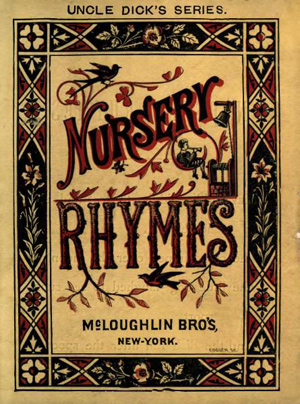
Source: Nursery Rhymes, Edward Cogger,
Wikimedia
A rhyme is a repetition of similar sounds. For hundreds of years, poets have used different kinds of rhymes to enhance the reader’s enjoyment and to generate emotional responses. Study the chart below to learn everything you need to know about different types of rhyme.
| Type of rhyme | Explanation | Example |
|---|---|---|
| Exact rhyme | The sounds in the last syllables of the words are identical. | Whose woods these are I think I know. His house is in the village though; (Robert Frost, “Stopping by Woods on a Snowy Evening”) |
| Inexact rhyme (also called slant, imperfect, or off rhyme) | The sounds in the words are similar but not identical, usually because the words have different vowels or consonants. | The whiskey on your breath Could make a small boy dizzy; But I hung on like death: Such waltzing was not easy. (Theodore Roethke, “My Papa’s Waltz”) |
| End rhyme | The rhyme occurs at the ends of lines. | Miniver loved the days of old When swords were bright and steeds were prancing; The vision of a warrior bold Would set him dancing. (Edwin Arlington Robinson, “Miniver Cheevy”) |
| Internal rhyme | The rhyme occurs within a single line. | Once upon a midnight dreary, while I pondered weak and weary, (Edgar Allan Poe, “The Raven”) |
Keep in mind that rhymes result from sound rather than spelling. Consider these words that rhyme with day: weigh, gray, bouquet, financé, matinee.
In the exercise that follows, you will read a few stanzas from Edgar Allan Poe’s “The Raven” and highlight end rhymes in pink and internal rhymes in green. The rhymes in the first stanza have been highlighted for you.
Once upon a midnight dreary, while I pondered, weak and weary,
Over many a quaint and curious volume of forgotten lore –
While I nodded, nearly napping, suddenly there came a tapping,
As of someone gently rapping, rapping at my chamber door –
“’Tis some visitor,” I muttered, “tapping at my chamber door –
Only this, and nothing more.”
Now, you try it with the second and third stanzas of “The Raven.” Click on the end rhymes to see them highlighted in pink and the internal rhymes to see them highlighted in green. You should find fifteen internal rhymes and eight end rhymes.

Let’s now take a look at inexact rhyme. Remember that inexact rhyme can have many names: slant, near, imperfect, or off. Inexact rhyme is called such because the sounds in the rhyming words almost rhyme. In exact rhyme, the rhyming words share the same vowel sound. These words may or may not share a consonant sound. Shared vowel sounds are called assonance. Shared consonant sounds are called consonance.
| Assonance (shared vowel sounds) | Consonance (shared consonant sounds) |
|---|---|
| The long i sound in bright and side | The lk sound in milk and walk |
To test your understanding of assonance and consonance, complete the Q and A activity below. Read the question; think of an answer, and when you’re ready, check your understanding to see a possible response.
Question: Can you find an example of slant rhyme created by assonance (shared vowel sounds) in the first line of Edgar Allan Poe’s “The Raven”?
Once upon a midnight dreary, while I pondered, weak and weary,
Sample Responses
“w[ea]k” and “w[ea]ry” share a similar vowel sound that changes slightly because of the “r” that follows the “ea” in “weary.”
Question: Now, can you find an example of slant rhyme created by consonance (shared consonant sounds) in this line from Edgar Allan Poe’s “The Raven”?
Desolate yet all undaunted, on this desert land enchanted –
Sample Responses
“[U]ndaunted” (not discouraged) and “enchanted” share three consonant sounds: the n sound in un and en at the beginning of each word, the nt sound in the middle of each word, and the d sound at the end of each word.
Rhyme is the element of poetry with which most readers are familiar. The matching of vowel or consonant sounds in two or more words brings pleasure to the reader who anticipates the echoing sounds.